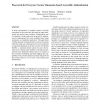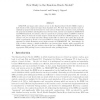138 search results - page 9 / 28 » A Practical Secure Physical Random Bit Generator |
DCC
2005
IEEE
14 years 6 months ago
2005
IEEE
Elliptic curve cryptosystems in the presence of faults were studied by Biehl, Meyer and M?uller (2000). The first fault model they consider requires that the input point P in the c...
FPL
2004
Springer
14 years 3 days ago
2004
Springer
Abstract. The paper presents a high performance True Random Number Generator (TRNG) embedded in Altera Stratix Field Programmable Logic Devices (FPLDs). As a source of randomness, ...
USENIX
2007
13 years 9 months ago
2007
In many environments, a computer system is severely constrained to the extent that the practical input mechanisms are merely binary switches. Requiring the user to remember a long...
CRYPTO
2009
Springer
14 years 1 months ago
2009
Springer
RSA-FDH and many other schemes secure in the Random-Oracle Model (ROM) require a hash function with output size larger than standard sizes. We show that the random-oracle instanti...
CHES
1999
Springer
13 years 11 months ago
1999
Springer
The strength of a cryptographic function depends on the amount of entropy in the cryptovariables that are used as keys. Using a large key length with a strong algorithm is false co...


